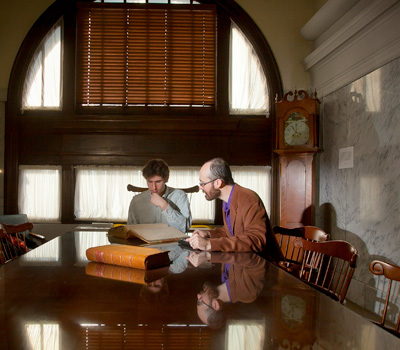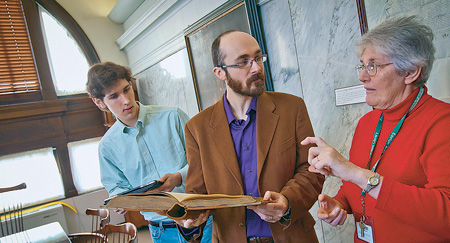In Our City: Reading Habits of 19th-Century Eastonians
In a joint project between Easton Area Public Library and Christopher Phillips, assistant professor of English, a database is under construction that will reveal the reading habits of the citizens of Easton 200 years ago.

Gavin Jones ’14 (left) and Christopher Phillips review 19th-century circulation records in historic Easton Area Library.
When Phillips discovered that the original circulation records of Easton Library Company still existed, he set out to capture the invaluable information. The company, formed in 1811, was the precursor to Easton Area Public Library.
Jennifer Stocker, Easton Library director, and Barbara Wiemann, senior coordinator for local history, have made the bound volumes of handwritten circulation records from 1811 to 1862 available to Phillips and his research assistant Gavin Jones ’14.
By transcribing the information, Phillips and Jones are creating what will be come a public database about the library’s use over a 50-year period. They anticipate having it completed sometime after 2012.
The project, part of the emerging research field of the history of reading, is among only four others in progress around the country and the only one with records dating from the early 1800s.
The first such public database, which set the stage for authoritative records of American reading, was launched last March and reported in the Nov. 23, 2011, New York Times article “What Muncie Read.” It is based on the library ledgers of Muncie (Ind.) Public Library from 1891 to 1902.
Also involved in Lafayette’s project are Diane Shaw, director of special collections and College archivist; Eric Luhrs, digital librarian; and Paul Miller, visual digital production manager.

Barbara Wiemann, the library’s senior coordinator for local history, works with them on the project.
Phillips gave a presentation at the library as part of its 200th-year anniversary celebration. A group of citizens formed the library company to loan books among each other and sold 100 shares. The price to join was $4, and the annual fee was $2. Of the original 100 members, three were women.
The collection grew to 4,000 volumes by 1860. At that time, Lafayette’s library had only 1,000 volumes, most of which, says Phillips, belonged to literary societies or faculty members.
The current Easton Library building was completed in 1903 with an Andrew Carnegie grant. Additions were made in 1911, 1941, and 1968. The current collection includes almost 225,000 volumes.